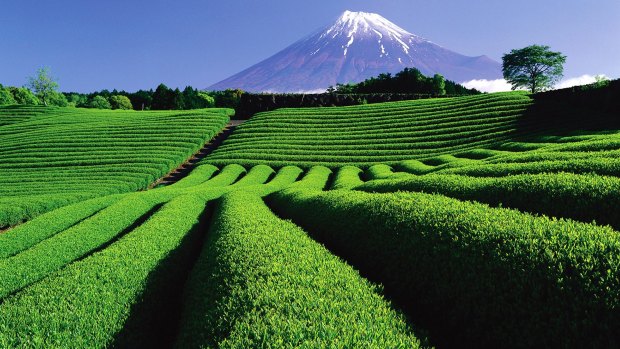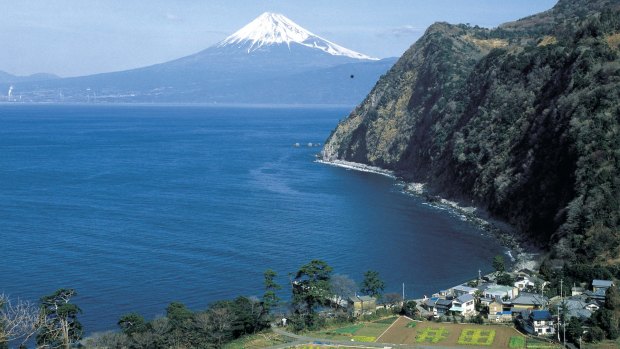This was published 6 years ago
The Izu Peninsula: An easy country escape from Tokyo
The rugged, forested Izu Peninsula juts into the Pacific Ocean just an hour south of Tokyo, making for a convenient escape to the country.

The tea plantations of Shizuoka.
When you're done with Tokyo's howling pachinko parlours, neon-winking skyscrapers and robot restaurants, a getaway is easy.
White-gloved attendants will usher you onto a bullet train and – whoosh! – you alight an hour later in Atami, gateway to the Izu Peninsula. Here de-stressing urbanites flop on beaches and kick back over buckwheat noodles in wood-lined eateries. Some make genteel visits to Kiunkaku mansion, host to notable Japanese writers, where it's easy to doze off in raked gardens scented with pine needles.
The Izu Peninsula's sea-pounded coastline features eroded lava cliffs and scalloped bays. At Irozaki, you can take a turbulent boat ride out into the waves. Shimoda, on the peninsula's southern end, has great surfing, Kawana and Inatori prime golf courses.

Izu Peninsula: eroded lava cliffs and scalloped bays.
Pacific breezes and beaches are a relief to summer humidity. Any time of year is lovely, though. Come in spring to admire the cherry blossoms; the town of Kawazu has a special variety of cherry tree that blooms early, in late February. In autumn, hillsides flaunt fiery foliage, best admired from the warm embrace of a hot spring. Wherever you are, the serene cone of Mount Fuji floats in the distance across bays or tea plantations. On the west coast, Lover's Cape is renowned for its sunsets. Giggling youngsters ring Lover's Bell while calling out the name of the person they want to marry. Mount Fuji looms in the distance across Suruga Bay, which turns to molten sunset gold.
Few foreigners come here despite the Izu Peninsula's accessibility. They used to, though. Atami was popularised in the 19th century by Sir Rutherford Alcock, first British consul-general to Japan and first westerner to climb Mount Fuji. At Ito, stop by the monument to William Adams, an English shipbuilder who built Japan's first Western-style ships in the 17th century. Further south, Shimoda was visited by American Commander Perry on his 1854 mission to Japan, and hosted the first American consulate.
Despite Japan's many Western influences, tradition is never far away. When in Ito visit Tokai-kan, a venerable inn of darkened wood overlooking the river, to have green tea and chestnut-jelly pastries. Ladies can take a course in geisha basics such as make-up, dancing and how to wear a kimono. The visitors' book is full of lipstick-marked kisses from satisfied customers.
Many of the peninsula's traditional-style inns are found at hot-spring resorts. In Ito, Yamatokan has steaming indoor baths as well as outdoor pools set among clipped gardens. At Osawa onsen near Matsuzaki, you can stay in an Edo-era residence and take a steaming dip surrounded by rice paddies. Inland at Shuzenji, the peninsula's oldest hot-spring resort, founded at least a thousand years ago, is set in bamboo groves by the Katsura River, spanned by bright red bridges. The little town is full of temples and street stalls selling bean-paste cookies.
Veer away from the coast and you'll escape the crowds that surge down the coast at weekends and during school holidays. Central Izu was made famous in the 1926 short story The Dancing Girl of Izu by Nobel Prize-winning author Yasunari Kawabata, in which a depressive university student is reinvigorated by his Izu hikes and encounter with a young dancer. You can follow the young lovers' trail, which leads to an abandoned road tunnel near Amagi that features in one of the tale's most moving scenes.
Irrespective of the story, you'll appreciate these hilly walks through forests of wild peach trees. A series of waterfalls culminates at Jyoren Fall, which plunges 25 metres through a deep basalt gorge. These moist valleys with their clear waters are perfect for wasabi production. Little terraced farms hide in the forest, erupting in shiny heart-shaped wasabi leaves, and you'll feel a million miles from Tokyo.
TRIP NOTES
MORE
FLY
Japan Airlines flies from Sydney and Melbourne daily to Tokyo. See au.jal.co.jp
STAY
Sanyo-So Ryokan is one of Japan's best traditional hotels, frequented by the emperor. Guests are served elaborately presented meals and sleep on tatami in rooms of minimalist beauty. Surrounding Japanese gardens are lovely. See princehotels.com
Brian Johnston travelled courtesy of Shizuoka Prefecture Tourist Association.
Sign up for the Traveller Deals newsletter
Get exclusive travel deals delivered straight to your inbox. Sign up now.